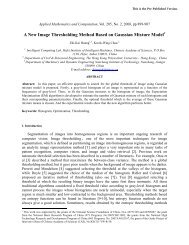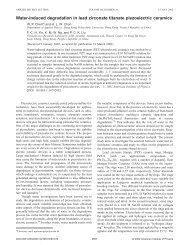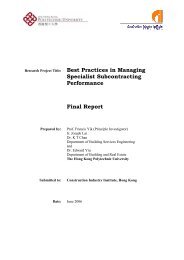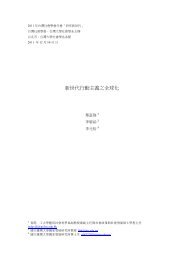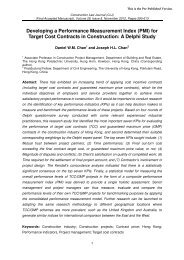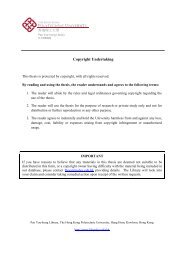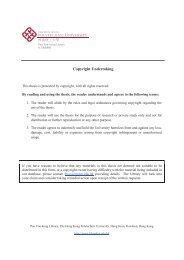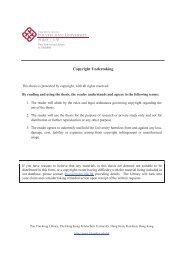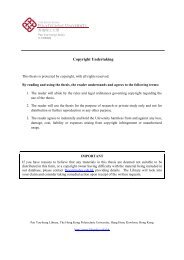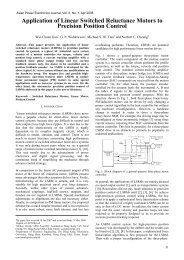Research Article Ginseng Extracts Restore High-Glucose Induced ...
Research Article Ginseng Extracts Restore High-Glucose Induced ...
Research Article Ginseng Extracts Restore High-Glucose Induced ...
Create successful ePaper yourself
Turn your PDF publications into a flip-book with our unique Google optimized e-Paper software.
2 Evidence-Based Complementary and Alternative Medicine<br />
Robert F. Furchgott, the Nobel Prize Laureate in Physiology<br />
or Medicine in 1998, discovered that acetylcholine<br />
induces endothelium-dependent relaxation in normal aortic<br />
tissue [4]. Upon early onset of atherosclerosis, endothelium<br />
can remain morphologically intact though inflammatory<br />
responses are triggered. Since then, numerous researches<br />
have been conducted to investigate the mechanisms of<br />
atherosclerosis to mitigate the associated diseases including<br />
adhesion of lipid-laden macrophages and smooth muscle<br />
cells which could finally result in endothelial denudation<br />
[5]. Besides, Hansson’s research groups have reported that<br />
high level of total cholesterol and low density lipoprotein<br />
accumulatedintheintimaofthearteries,withtheattackof<br />
myeloperoxidase and lipoxygenases, or by reactive oxygen<br />
species [6, 7] could also cause the early onset of atherosclerosis.<br />
The primary objective of this study is to evaluate the<br />
protective effects of Panax ginseng on diabetes mellitus,<br />
a pathological condition which links to endothelial dysfunctions,<br />
through investigating the physiological parameters<br />
such as blood glucose, blood cholesterol, insulin, and<br />
advanced glycation end product in diabetic rat models.<br />
Furthermore, the changes of atherosclerosis-related genes<br />
expression in diabetic rats are also investigated after ginseng<br />
administration. The findings may help in the development<br />
of successful therapeutic interventions for atherosclerotic<br />
cardiovascular disease.<br />
2. Materials and Methods<br />
Thisstudyfollows“TheInternationalGuidingPrinciples<br />
for Biomedical <strong>Research</strong> Involving Animals,” The Hong<br />
Kong Code of Practice for Care and Use of Animals for<br />
Experimental Purposes (2004). All experimental procedures<br />
were conducted according to the Animals (Control of Experiments)<br />
Ordinance of the Department of Health, HKSAR<br />
(Animal Licenses ID: (11-6) DH/HA&P/8/2/6 Pt.2; (10-4)<br />
DH/HA&P/8/2/6 Pt.1; (10-9) DH/HA&P/8/2/6 Pt.1). All animal<br />
studies were performed in facilities approved by the<br />
Animal Ethics Committee of the Chinese University of Hong<br />
Kong (10/028/MIS).<br />
2.1. Animals. Male Sprague-Dawley (SD) rats weighing 150–<br />
200 grams were housed in room under standard vivarium<br />
conditions with 12 hour light/dark cycle. Throughout the<br />
experimental period, animals were fed with standard rodent<br />
chow and water available ad libitum.Theanimalswereacclimatized<br />
to the laboratory conditions for 10 days prior to the<br />
inception of experiments. Experimental diabetic condition<br />
was induced in rats by a single intraperitoneal injection (i.p.)<br />
of streptozotocin (75 mg/kg body weight) freshly dissolved in<br />
cold citrate buffer (0.1 M), while the normal control group<br />
was injected with citrate buffer only. Blood samples were<br />
collected from tail veins of overnight-fasted rats three days<br />
after streptozotocin administration. Rats with blood glucose<br />
level higher than 16.7 mmol/dL were selected for experiment.<br />
The experimental rats were divided into seven groups:<br />
(1) normal control rats administered with water, (2) diabetic<br />
group of rats administered with water, (3) diabetic<br />
group administered with intraperitoneal injection of<br />
insulin, (4) diabetic group fed with PPT-type of ginseng<br />
(10 mg/kg/day), (5) diabetic group fed with PPT-type of<br />
ginseng (30 mg/kg/day), (6) diabetic group fed with PPDtype<br />
of ginseng (10 mg/kg/day), and (7) diabetic group fed<br />
with PPD-type of ginseng (30 mg/kg/day). The dosage of<br />
insulin followed a protocol developed by Kuo et al. [8], and<br />
waterordrugswereadministeredforatotalof14consecutive<br />
treatment days. Both PPD and PPT were administered orally<br />
in the form of aqueous suspension. Rats were anaesthetized<br />
by Ketamine-Rompun mixture (7.5 : 1), and blood was collected<br />
from the heart for further analysis. The animals were<br />
then sacrificed immediately by cervical dislocation. Aortae<br />
were removed and trimmed for tissue bath experiment. Other<br />
rat tissues including brain, heart, liver, spleen, eye, kidney,<br />
and aorta were immediately removed and instantly soaked in<br />
liquidnitrogenandstoredat−70 ∘ C for further biochemical<br />
analysis.<br />
2.2. <strong>Ginseng</strong> Preparation. Panax ginseng extract was prepared<br />
as described in Zhu et al. [9], which meets the requirement<br />
of the Chinese Pharmacopoeia and Hong Kong Standard<br />
of Chinese Materia Medica. Standardized ginseng extract<br />
(RSE) was prepared by ethanol extraction. The residue was<br />
then dissolved in water and partitioned successively with<br />
petroleum ether, EtOAc, and n-BuOH to give the petroleumether-soluble,<br />
EtOAc-soluble, and n-BuOH-soluble fractions.<br />
The n-BuOH extract was subjected to column chromatographyelutedwithaCHCl<br />
3 /MeOH gradient. Fractionated<br />
samples were combined and obtained according to the thin<br />
layer chromatography analysis. All samples were then stored<br />
in desiccated condition until further use. <strong>High</strong> performance<br />
liquid chromatography was used to confirm the identity of<br />
our samples with the standard ginsenosides (HPLC purity<br />
>98%) purchased from Chengdu Scholar Bio-Tech Co. Ltd.<br />
(Chengdu, China) or National Institute for the Control of<br />
Pharmaceutical and Biological Products (Beijing, China).<br />
The contents of ginsenosides Rg1, Re, Rb1, Rc, Rb2, and<br />
Rd were 290.9, 339.6, 246.3, 231.3, 136.0, and 84.5 mg/g,<br />
respectively (Figure 1 and Table 1).<br />
2.3. Measurement of Contractile and Relaxant Responses<br />
in the Rat Aortic Rings. Similar procedures were followed<br />
according to the protocol as described by Chan and Fiscus<br />
2002 [10]. Briefly, thoracic aortae were isolated by cutting<br />
from the aortic arch to the diaphragm, resulting in a length<br />
of 30–40 mm tissue. In order to prevent physical damage<br />
of endothelium by forceps, the parts from the aortic arch<br />
were not used for experiment. Fat tissues were trimmed off<br />
from the aortae and before it was cut into 3 mm segments<br />
rings. The segments were then mounted carefully between<br />
two platinum hooks in 10 mL organ baths containing Krebs<br />
buffer (KRB) maintained at 37 ∘ Cbubbledwith95%O 2 –5%<br />
CO 2 continuously. Following a 30 min equilibration period of<br />
resting tension of 1 gram, cumulative doses of phenylephrine



